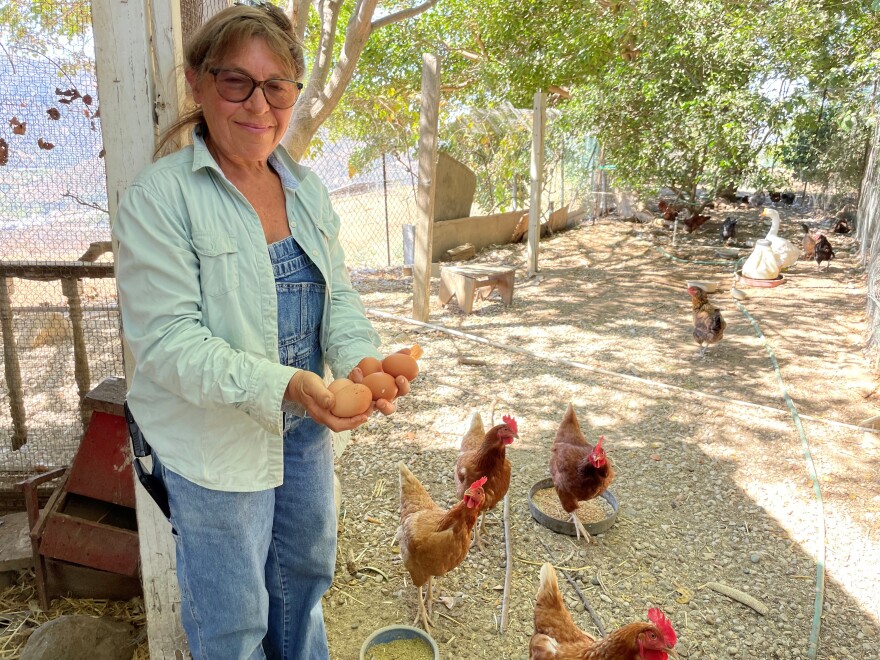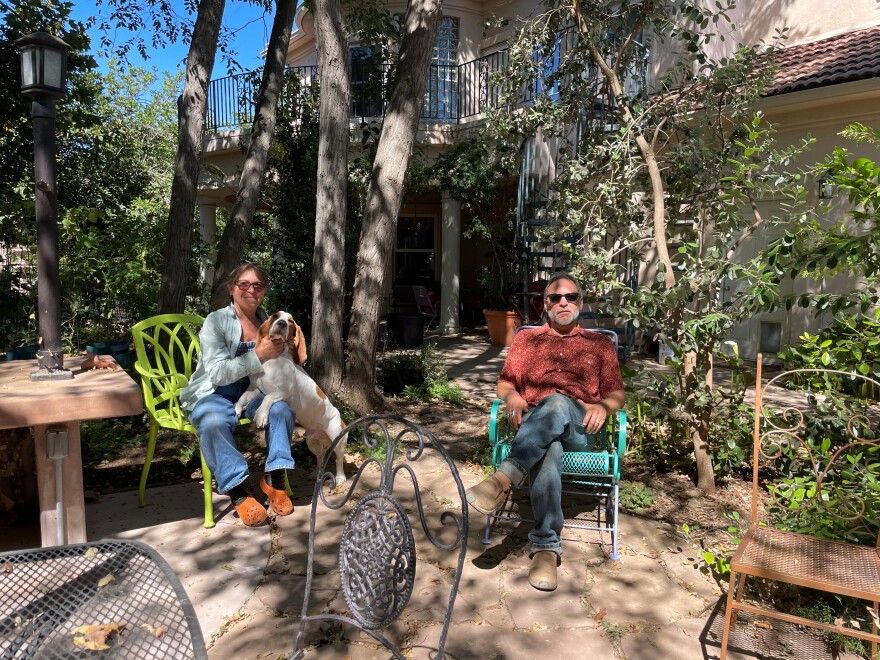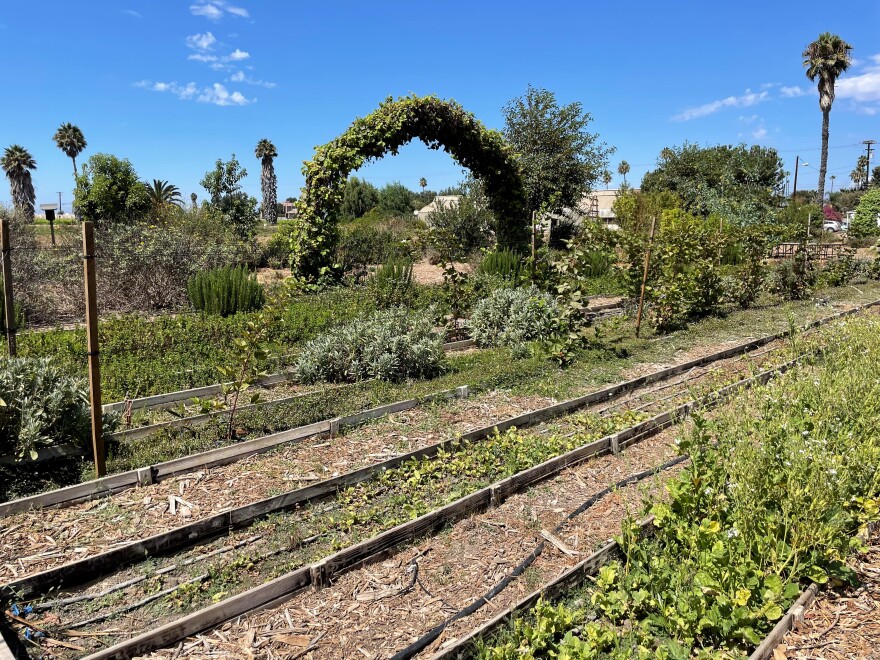The story comes from KCLU’s podcast The One Oh One. You can listen to the full episode here.
To reach U4EA (Euphoria) Ranch you have to take a narrow, winding, gravel road all the way up to the top of a mountain in Newbury Park — it’s 1,600 feet above sea level to be precise.
The small ranch is so high up that radio towers are stationed on a nearby peak. The view of Ventura County and the ocean below is spectacular.
Tina Rasnow and her brother Brian co-own the ranch. They produce fruit, honey and eggs that they keep for themselves. They sell exotic fruit like pineapple guava and dragon fruit.
This has been their home for the last fifty years.
On the day I visit, Opie, their two-year-old basset hound greets me and then Tina takes me on a tour.
First we check in on the sheep who keep all the vegetation trimmed, creating a defensible space in case of a wildfire.
“Hey Shirley. Hello Ladybug,” said Tina greeting her sheep.
Tina says all the animals play an important part on their ranch in keeping the soil healthy.
“All the animals — they have a role in building soil. The chickens also provide us with wonderful eggs and they eat bugs that would destroy the crops and they scratch in the soil, which helps to aerate it and just improve the health of it,” said Tina.

Massive trees shade the main house including an avocado tree that Tina says her daughter planted as a child.
“They drop their leaves in the winter so the sun can warm the house. And in the spring they put out new leaves. And so by summer I have wonderful shade,” said Tina.
Lots of leaves have been dropping from the trees. Tina begins sweeping them up to put them on an organic farmyard waste heap a little distance away from the house.
We take a walk to that area.
“And then when we get a lot piled up here, then my brother will bury them to avoid them burning if a fire were to come through. So we're not releasing all that carbon back into the air,” said Tina.
Tina’s brother Brian Rasnow explains that they push the organic material into a hole and cover it with dirt.
Besides being a farmer, Brian is also a physics and climate disruption lecturer at Cal State Channel Islands. He was able to calculate how much carbon he kept out of the atmosphere by doing this work.
“So after spending a couple of weeks doing long and hard work on a bulldozer and excavator, I estimated that I put about 50 tons of carbon permanently out of atmospheric circulation by burying it,” said Brian.

Carbon Capture is all about the soil
Further north from Brian and Tina’s ranch, just off the 101 in Camarillo, is the larger McGrath Family Farm where they farm about 250 acres of organic crops.
“We are on the foothills of the Oxnard Plains. This is the most fertile region in the world. I'm biased. Yes, I am,” said Phil McGrath. His family have been farming this land since the 1860s.
“Everybody wants to be here because of our climate and our soil. We grow everything. We can grow anything,” said McGrath.
There’s berries, pomegranates and California sage. There’s also a cover crop called kurapia that is planted just to keep the soil healthy. McGrath loves kurapia.
“That's a root system that goes four feet deep. It takes no water and completely increases microbial life in the soil.
The soil is key to carbon storage — also known as carbon sequestration, McGrath says.
“Now we understand there's too much carbon in the air. We have global warming, climate change and plants take carbon out of the air and put it in the soil,” said McGrath.
To maintain healthy soil and plants, McGrath says keep the ground covered with vegetation and practice crop rotation and diversity.
“Put a cover crop in between my lemon rows. Rotate your strawberry ground with a cover crop. Do something for the soil. An ideal farm to me is a diversified farm that's trying to cool the planet, keep the soil green,” said McGrath.

The California arm of the Rodale Institute is actually located at this farm — its a 70 plus year old nonprofit that promotes organic farming and provides research and education on the practice.
The institute says organic agriculture releases 40 percent fewer carbon emissions than conventional farming.
Carbon capture at the ag company billed the largest fresh berry producer in the world
So we’ve seen what a small farm is trying to do and what a larger commercial organic farm is doing by keeping the soil healthy. What about one of the larger ag industries in this region?
I head further north into Oxnard to a strawberry farm about half a mile from the ocean.
Luis Calderon says this location is ideal for strawberry growing.
“This is one of the only areas that we can plant and produce two seasons of strawberries in one year,” said Calderon.
Calderon is director of partners, growers and resources for Reiter Affiliated Companies. They call themselves the largest fresh berry producer in the world.
On the day I visit, workers are busy picking berries in the field. They’re playing music as they work. As we walk between the beds of juicy strawberries Calderon reminisces of the time his mother spent picking strawberries. Both his parents were farmworkers.
“My mom picked through when she was seven months pregnant with me. And that's why she always tells me she's like, 'That's probably why you love strawberries so much',” chuckles Calderon.

How does this massive ag company, that farms thousands of acres locally, approach their soil?
“I've always thought about soil like skin. You know, you don't want skin to just be 100 percent exposed to the sun. You want to have some type of sunblock or something. Then that's kind of like the way we look at it too, is you want to protect your soil,” said Calderon.
For them — just like the McGrath organic farm — that means crop rotation with celery and cilantro growers; making sure the ground is covered with cover crops between seasons. Also using worm compost and fungi to improve the soil quality.
They know healthy soil is good for business but where does carbon capture come into the equation? Right now, they’re just trying to figure out what their actual carbon footprint is.
“I think carbon capture is that next challenge for us. It’s how are we not only, you know, a highly productive operation. How are we sustainable,” said Calderon.
What difference are these carbon capture efforts making
So farmers, big and small, are practicing some kind of carbon capture because it’s good for the planet and business. But what difference is it actually making?
To get that answer we have to head back to Brian Rasnow on the mountain top ranch in Newbury Park. Rasnow is the farmer and climate disruption lecturer.
Now remember Rasnow estimated he kept 50 tons of carbon out of the atmosphere when he buried that organic farmyard material.
“The average American generates about 15 tons of carbon a year. In a week of work, I sort of bought myself three years of living and polluting,” said Rasnow.
In 2018 the U.S. emitted six billion tons of carbon dioxide. Essentially we’d need 120 million Brians to get to carbon neutrality for that year alone.
“There's nothing I can do that gets anywhere near the scale. And even if I were to bring as many farmers that I know together and say, let's all do this collectively, we're still sort of moving grains of sand around while there are other individuals moving bulldozer's worth of material and getting super rich by doing it and destroying the planet for everyone,” said Rasnow.
Rasnow is referring here to many of the largest manufacturers in the country.
He also says it does not pay, literally, to do this kind of work. Rasnow estimates it cost him up to $750 in fuel.
“I lost money on it. This was charity. And it shouldn't be, right. We need a system that encourages doing the right thing instead of discouraging it,” said Rasnow.
What these carbon captors want you to know is no matter who you are, whether you’re a mega-polluting nation signing agreements at COP26, or a small-scale farmer on California’s Central, South Coasts, carbon capture is something that can be done by almost anyone — even if it’s just by keeping your backyard soil healthy.
For Brian Rasnow he knows his impact is small but he’s got hope.
“All revolutions, or all change, always starts with an individual. So if we're waiting for the group, well, a group is made of individuals. We have to start where we can, each of us,” said Rasnow.
------------------------------------------------------------------------------------------------
If you're looking for The One Oh One® Design Collective visit: https://www.theoneohone.com/



